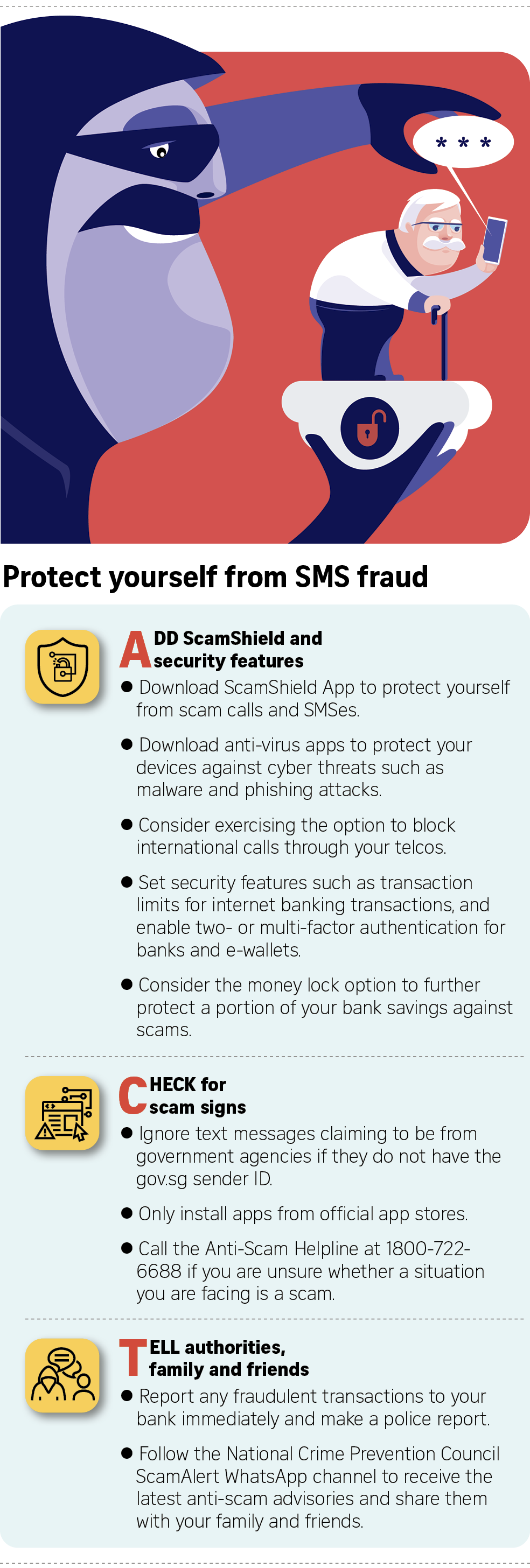BRANDED CONTENT
Received an SMS from the Government? Here's an easy way to tell if it's real
From July 1, all SMSes sent from Government agencies, ministries, statutory boards, and services will show ‘gov.sg’ as the sender ID

The consolidation of sender IDs under gov.sg should help reduce the likelihood of people falling prey to scam messages pretending to be from the Government, says the police.
PHOTO: GETTY IMAGES
Kareyst Lin, Content STudio
Follow topic:
Her phone buzzes with a familiar notification from her parents: It is yet another screenshot of SMSes containing unsolicited links.
“Is this real? Can I click?” Ms Seow Xin Er’s parents, both in their early 60s, would ask.
These messages often claim to be from government agencies like Central Provident Fund (CPF) and Inland Revenue Authority of Singapore (Iras), says the 32-year-old communications professional.
Reports of frauds, such as phishing scams and those involving government imposters have made the elderly couple edgy over the SMSes they receive. But “they are also worried it could be a (legitimate) text message from the Government,” Ms Seow says.
As her parents are “not so digitally savvy”, she adds, “it’s hard for them to understand how to identify scams or suspicious messages.”
Now, there is an easier way to tell if a text message is really from the Government.
Since July 1, all SMSes sent from government agencies show “gov.sg” as the sender ID, except text messages on National Service matters and emergency services. View full list of exceptions on sms.gov.sg/exceptions.
The gov.sg sender ID “makes it easier for the public to verify authentic government communications sent by SMS, with greater confidence and accuracy,” says Mr Hygin Fernandez, assistant director for policy, Open Government Products (OGP).
“Telecommunications service providers and SMS aggregators will consistently block SMSes with fake sender IDs that resemble gov.sg,” he adds.
OGP is a division of the Government Technology Agency that focuses on building technology for the public good.
Ways to stay safe
- Friend or fraudster: When you receive unusual requests from a “friend” via text message or phone call, beware. Verify their identity first. More on how fake friend call scams work.
- Guard your chat space: Frustrated at unsolicited messages from strangers on WhatsApp or Telegram? Here are the safety features you can activate on the platforms.
Verify easily
A legitimate SMS from the Government should have all four of these indicators:
- The sender ID is gov.sg with all letters in lowercase.
- The SMS begins with the full name of the agency or service that sent it.
- The SMS ends with this signature: “This is an automated message sent by the Singapore Government.”
- SMSes from gov.sg are grouped into a single conversation, even if they are from different agencies.
Ms Seow welcomes the initiative. “It’ll definitely be helpful for people of the older generation, like my parents,” she says, “as it’s a lot less confusing.”
The consolidation of sender IDs under gov.sg should help reduce the likelihood of people falling prey to scam messages pretending to be from the Government, says Police Superintendent Matthew Choo, assistant director of the Scam Public Education Office, Singapore Police Force.
He emphasises that government officials, especially police officers, will never ask the public to do the following over the phone or through text messages:
- Transfer money to bank accounts;
- Request for your personal, banking, SingPass or CPF-related information;
- Ask you to click on links that lead to bank websites; or
- Ask you to install applications or software from third-party websites.

This is part of a series titled "Act against scams", in partnership with the Singapore Police Force.

